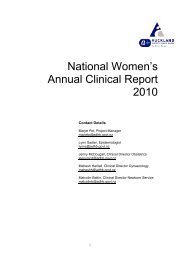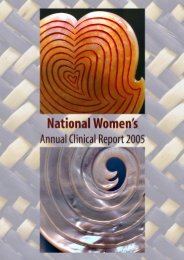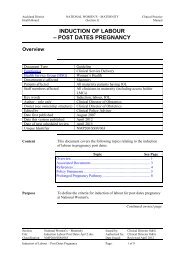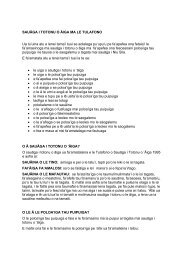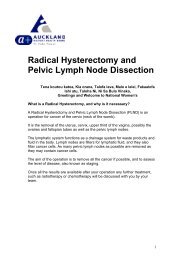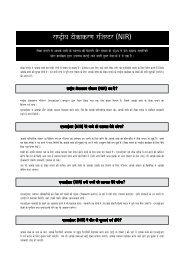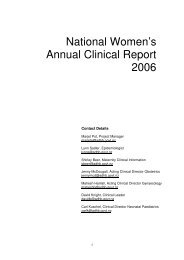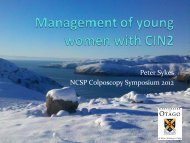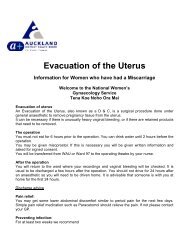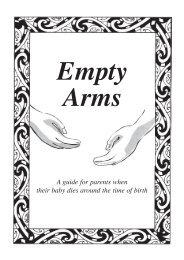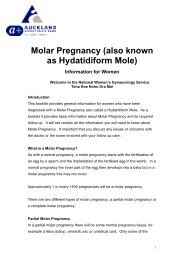Tongue-tie –myth or reality? - National Women's Hospital
Tongue-tie –myth or reality? - National Women's Hospital
Tongue-tie –myth or reality? - National Women's Hospital
Create successful ePaper yourself
Turn your PDF publications into a flip-book with our unique Google optimized e-Paper software.
<strong>Tongue</strong>-<strong>tie</strong> <strong>–myth</strong> <strong>or</strong> <strong>reality</strong>?<br />
Simon Rowley<br />
August 2010
<strong>Tongue</strong>-Tie (Ankyloglossia)<br />
Current Concepts<br />
• ‘an outdated concept –a relic of times past’<br />
<strong>or</strong><br />
• ‘a recognised cause of breast feeding<br />
difficul<strong>tie</strong>s –and a very easily c<strong>or</strong>rected<br />
one’
<strong>Tongue</strong> -Tie<br />
• Bottom of the tongue tethered to the flo<strong>or</strong><br />
of the mouth by a membrane (frenulum)<br />
causing restriction of the tongue’s range of<br />
movements<br />
• May result in feeding, speech, swallowing<br />
and associated <strong>or</strong>al development<br />
problems
The Lingual Frenulum -function<br />
• During early gestation (as early as 4<br />
weeks) the lingual frenulum serves as a<br />
guide f<strong>or</strong> the f<strong>or</strong>ward growth of the tongue<br />
• After birth the tip of the tongue continues<br />
to elongate, giving the impression of the<br />
frenulum retracting, though in <strong>reality</strong> this<br />
has been going on f<strong>or</strong> some time bef<strong>or</strong>e<br />
birth.
M<strong>or</strong>phological Differences between<br />
Neonatal and Adult <strong>Tongue</strong><br />
• The neonatal tongue has-<br />
-thinner mucosa over d<strong>or</strong>sal and ventral<br />
aspects<br />
- very little fat and subcutaneous tissue<br />
-larger extrinsic muscles (especially<br />
styloglossus) –involved in movement of<br />
tongue en bloc
<strong>Tongue</strong>-<strong>tie</strong><br />
• Rep<strong>or</strong>ted incidence 1.7- 4.8%<br />
• No universal tool f<strong>or</strong> assessment<br />
• No diagnostic criteria<br />
• Diagnosis made on basis of<br />
• a) anatomical appearance of tongue<br />
• b) functional disturbance<br />
• Much debate, disagreement
<strong>Tongue</strong>-Tie types<br />
• Type 1 attachment of frenulum to tip in<br />
front of alveolar ridge in lower lip sulcus<br />
• Type 2 attaches 2-4 mm behind the<br />
tongue tip and attaches on alveolar ridge<br />
• Type 3 attaches to the mid tongue and<br />
middle of flo<strong>or</strong> of mouth usually tighter and<br />
less elastic<br />
• Type 4 attaches against base of tongue<br />
and is shiny and very inelastic
Bottle vs Breast Feeding<br />
• Bottle fed infants who are tongue <strong>tie</strong>d can<br />
trigger the ‘phasic bite reflex’ =chewing.<br />
• Breast fed infants who are tongue <strong>tie</strong>d<br />
cannot initiate tongue grooving, cupping <strong>or</strong><br />
depression.<br />
• <strong>Tongue</strong>-<strong>tie</strong> may interfere with front to back<br />
peristalsis as well as tongue palate<br />
synchronisation in breast feeding.
<strong>Tongue</strong> –Tie<br />
- diagnostic assessment<br />
• Physical examination<br />
• Rule out thrush, clefts, other defects incl. neuromuscular<br />
-range of motion and degree of extension of tongue beyond<br />
lower dental ridge and lip<br />
-elevation to palate with mouth wide open<br />
-transverse movement without twisting the tongue<br />
• Observation of breast feeding<br />
-adequacy of latch and milk transfer<br />
-test weigh<br />
-efficiency of bolus handling<br />
-fatigue and irritability during/after feeding<br />
-document degree of nipple pain and nipple skin erosion
Hazelbaker Assessment Tool f<strong>or</strong> Lingual Frenulum<br />
Function (HATLFF) (Ballard et al.Paediatrics 2002;110)<br />
• Appearance Items<br />
Appearance of tongue when lifted<br />
2: Round <strong>or</strong> square<br />
1: Slight cleft in tip apparent<br />
0: Heart- <strong>or</strong> V-shaped<br />
Elasticity of frenulum<br />
2: Very elastic<br />
1: Moderately elastic<br />
0: Little <strong>or</strong> no elasticity<br />
Length of lingual frenulum when tongue lifted<br />
2: >1 cm<br />
1: 1 cm<br />
0:
Hazelbaker Assessment Tool f<strong>or</strong> Lingual Frenulum<br />
Function (HATLFF (Ballard et al.Paediatrics 2002;110)<br />
Function Items<br />
Lateralization<br />
2: Complete<br />
1: Body of tongue but not tongue tip<br />
0: None<br />
Lift of tongue<br />
2: Tip to mid-mouth<br />
1: Only edges to mid-mouth<br />
0: Tip stays at lower alveolar ridge<br />
<strong>or</strong> rises to mid-mouth only with jaw<br />
closure<br />
Extension of tongue<br />
2: Tip over lower lip<br />
1: Tip over lower gum only<br />
0: Neither of the above, <strong>or</strong> anteri<strong>or</strong><br />
<strong>or</strong> mid-tongue humps<br />
Spread of anteri<strong>or</strong> tongue<br />
2: Complete<br />
1: Moderate <strong>or</strong> partial<br />
0: Little <strong>or</strong> none<br />
Cupping<br />
2: Entire edge, firm cup<br />
1: Side edges only, moderate cup<br />
0: Po<strong>or</strong> <strong>or</strong> no cup<br />
Peristalsis<br />
2: Complete, anteri<strong>or</strong> to posteri<strong>or</strong><br />
1: Partial, <strong>or</strong>iginating posteri<strong>or</strong> to tip<br />
0: None <strong>or</strong> reverse motion<br />
Snapback<br />
2: None<br />
1: Periodic<br />
0: Frequent <strong>or</strong> with each suck
Maternal Presentation of <strong>Tongue</strong> -<br />
Tie<br />
• nipple pain and/<strong>or</strong> erosions<br />
• painful breasts<br />
• low milk supply<br />
• plugged ducts<br />
• mastitis<br />
• frustration, disappointment,<br />
discouragement with breast feeding<br />
• untimely weaning
Infant Presentation of tongue -Tie<br />
• po<strong>or</strong> latch and suck<br />
• clicking sound while feeding<br />
• ineffective milk transfer<br />
• inadequate weight gain<br />
• irritability <strong>or</strong> colic<br />
• fussiness and arching at breast<br />
• fatigue within one <strong>or</strong> two minutes<br />
• po<strong>or</strong> suction to maintain deep grasp on breast<br />
• ‘chewing of the nipple’<br />
• Gradual sliding off the breast<br />
• falling asleep bef<strong>or</strong>e adequate volume taken
Ankyloglossia: incidence and associated feeding<br />
difficul<strong>tie</strong>s: Messner et al :Arch Otolaryngol Head<br />
Neck Surg. 2000 Jan;126<br />
• Outcome measures –incidence of<br />
ankyloglossia, and breastfeeding rates<br />
and difficul<strong>tie</strong>s.<br />
• 1041 babies screened in well baby<br />
nursery.<br />
• 50 newb<strong>or</strong>ns identified (4.8%) with<br />
ankyloglossia and invited to participate.<br />
• Telephone interviews monthly f<strong>or</strong> 6<br />
months.
Results : Messner<br />
• Incidence 4.8% (n=50/1041)<br />
• M:F =2.6:1<br />
• 30/36 (83%) mothers intending to breastfeed<br />
followed up were still breastfeeding at 2 months<br />
vs 33/36 (92%) of matched controls (p=0.9)<br />
• Breastfeeding difficul<strong>tie</strong>s experienced by 25%<br />
mothers of infants with ankyloglossia versus<br />
1/36(3%) of controls (p
Ankyloglossia: Controversies in<br />
Management : Messner et al Int J Pediatr<br />
Ot<strong>or</strong>hinol 2000 Aug 31;54(2-3):123-31<br />
• Aim: to determine beliefs regarding<br />
ankyloglossia and its treatment<br />
• Method : anonymous written survey<br />
• Participants : ot<strong>or</strong>hinolarygologists<br />
(n=423), paediatricians (n=425), speech<br />
pathologists (n=400), lactation consultants<br />
(n=350) randomly selected.<br />
• Response rates approx 50%
Results : Messner and Lalakea<br />
• 69% lactation consultants believe that tongue-<strong>tie</strong><br />
is definitely associated with feeding problems vs<br />
min<strong>or</strong>ity of physicians<br />
• 60% of ENTs and 50% of SLTs but only 23% of<br />
Paeds believe tongue <strong>tie</strong> is sometimes<br />
associated with speech difficul<strong>tie</strong>s<br />
• Surgery recommended f<strong>or</strong> speech, feeding,<br />
social/mechanical difficul<strong>tie</strong>s by approx 65% of<br />
ENTs vs approx 23% of Paeds
Frenotomy<br />
The procedure involves<br />
holding the tongue<br />
up towards the roof of the mouth<br />
to make the frenulum taut,<br />
then cutting through<br />
the white, fascia-like tissue<br />
along a line parallel with,<br />
and fairly close to, the tongue.<br />
The cut is made in a single motion<br />
in less than a second.
Ankyloglossia: Assessment, Incidence, and Effect<br />
of Frenuloplasty on the Breastfeeding Dyad.<br />
Ballard et al Pediatrics vol 110 no 5 November<br />
2002 pp.e63<br />
• Aim: define significant ankyloglossia, determine<br />
incidence in breastfeeding infants, measure<br />
effectiveness of frenuloplasty.<br />
• Methods: 2763 breastfeeding inpa<strong>tie</strong>nts and 273<br />
outpa<strong>tie</strong>nts with breastfeeding problems<br />
assessed using ATLFF (Hazelbaker)<br />
• Latch,pain, sensation, quality of suckling were<br />
described. If lingual function impaired,<br />
frenuloplasty offered and consented
Results: Ballard<br />
• Ankyloglossia diagnosed in 88/2763<br />
(3.2%)inpa<strong>tie</strong>nts and 35/273(12.8%)outpa<strong>tie</strong>nts<br />
• All frenuloplas<strong>tie</strong>s perf<strong>or</strong>med without incident<br />
• Latch improved in all cases<br />
• Maternal pain levels fell significantly after the<br />
procedure<br />
• Conclusions: Ankyloglossia is relatively<br />
common, contributes to a significant prop<strong>or</strong>tion<br />
of breastfeeding problems –po<strong>or</strong> latch and<br />
nipple pain included, and frenuloplasty when<br />
indicated by careful assessment of lingual<br />
function is a successful approach.
Randomised, controlled trial of division of<br />
tongue-<strong>tie</strong> in infants with feeding problems.<br />
Hogan et al. J Paediatr Child Health. 2005<br />
May-June;41(5-6):242<br />
• Ethically approved, prospective,<br />
• Aim: to compare current medical treatment<br />
(referral to lactation consultant) with immediate<br />
division f<strong>or</strong> infants with tongue-<strong>tie</strong><br />
• Method: All infants with tongue <strong>tie</strong>s b<strong>or</strong>n(5 units)<br />
over a 5 month period inspected f<strong>or</strong> tongue-<strong>tie</strong><br />
and followed f<strong>or</strong> feeding problems. Mothers<br />
consented enrolled, and if feeding problems<br />
occurred, randomised to either 48 hours<br />
intensive lactation supp<strong>or</strong>t <strong>or</strong> immediate division
Results : Hogan trial<br />
• 201 babies identified of 1866 b<strong>or</strong>n (10.7%)<br />
• 88(44%) had feeding problems (breast <strong>or</strong> bottle)<br />
• 57 randomised (40 breastfed, 17 bottle fed)<br />
• 28/29 controls did not improve at 48hrs were then<br />
offered division and 27/28 (96%) improved and fed<br />
n<strong>or</strong>mally<br />
• 27/28 babies offered immediate division improved and<br />
fed n<strong>or</strong>mally (p
Review of tongue <strong>tie</strong> release at a<br />
tertiary maternity hospital :<br />
Lisa Amir et al J Paediatr Child Health. 2005<br />
May-June;41(5-6)<br />
• 12 month review of assessment (using ATLFF)<br />
and release of lingual frenulum and rep<strong>or</strong>t on<br />
breastfeeding outcomes<br />
• Telephone interview 3 months after the<br />
assessment and release (if done)<br />
• 66 infants referred and assessed (follow-up data<br />
on 46 presented –20 had incomplete data <strong>or</strong><br />
were lost)<br />
• 35/46 had frenotomy, with 28/35 (83%) rep<strong>or</strong>ting<br />
improved breastfeeding<br />
• High parental satisfaction and no complications
Amir :Most imp<strong>or</strong>tant Presenting Problem in<br />
infants assessed as having significant<br />
tongue-<strong>tie</strong><br />
• Attachment to the<br />
breast<br />
• Nipple Pain<br />
• Prolonged feeding<br />
• Po<strong>or</strong> weight gain<br />
• Frequent feeding<br />
• Nipple damage<br />
N=12 (44%)<br />
6 (22%)<br />
5 (19%)<br />
2 (7%)<br />
1 (4%)<br />
1 (4%)
Frenulotomy f<strong>or</strong> Breastfeeding Infants With<br />
Ankyloglossia: Effect on Milk Removal and<br />
Sucking Mechanism as Imaged on Ultrasound<br />
Donna Geddes et al Pediatrics 2008.132<br />
• 24 mother infant dyads experiencing breastfeeding<br />
difficul<strong>tie</strong>s<br />
• Submental ultrasound scans of <strong>or</strong>al cavity bef<strong>or</strong>e and >7<br />
days after frenotomy<br />
• Milk transfer, pain, LATCH sc<strong>or</strong>es* assessed bef<strong>or</strong>e and<br />
after frenotomy<br />
• All infants demonstrated significant improvement in milk<br />
intake, LATCH sc<strong>or</strong>e and pain sc<strong>or</strong>es<br />
• Sucking dynamics described-23 improved after<br />
procedure<br />
• * latch, audible swallowing, type of nipple, comf<strong>or</strong>t, and<br />
hold
Efficacy of Neonatal Release of<br />
Ankyloglossia: a Randomised Trial<br />
Buryk et al Pediatrics 2011;128<br />
• Randomised single blind trial<br />
• Neonates with breast feeding difficul<strong>tie</strong>s<br />
• Frenotomy (30) vs sham procedure(28)<br />
• Pre- and post- intervention assessments using HATLFF<br />
and nipple pain sc<strong>or</strong>e<br />
• Both groups showed decreased pain sc<strong>or</strong>es (p
<strong>Tongue</strong>-<strong>tie</strong> : my conclusions<br />
<strong>Tongue</strong> <strong>tie</strong> exists<br />
Not all tongue-<strong>tie</strong> is problematic<br />
There is less acceptance of failure to breastfeed<br />
successfully –the goalposts have shifted.<br />
Health professionals should listen to the mothers<br />
(nipple pain/discomf<strong>or</strong>t)<br />
There is no reliable tool f<strong>or</strong> assessment (in all<br />
hands)<br />
<strong>Tongue</strong>-<strong>tie</strong> can safely be divided (without undue<br />
pain?) in the neonatal period<br />
Paediatricians are the least receptive to frenotomy<br />
- the literature reflects this



